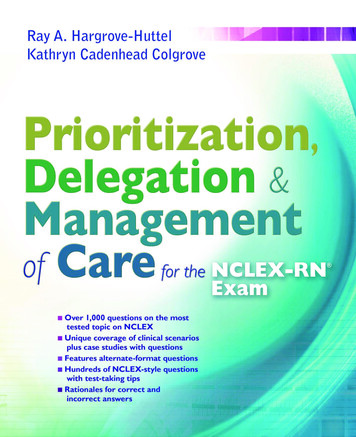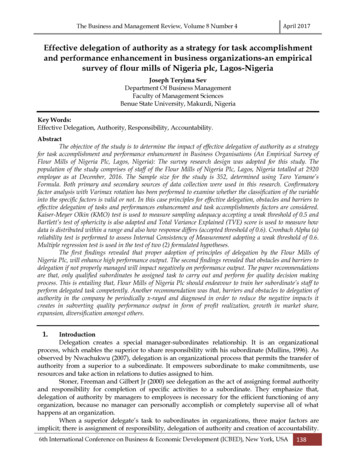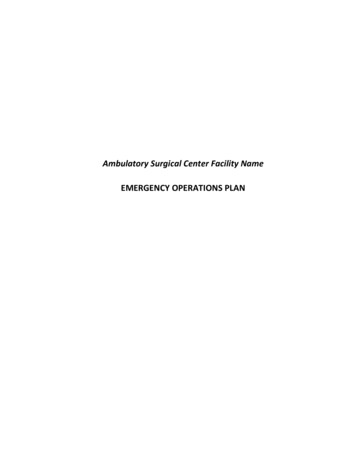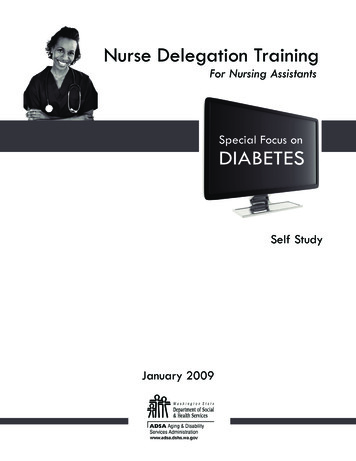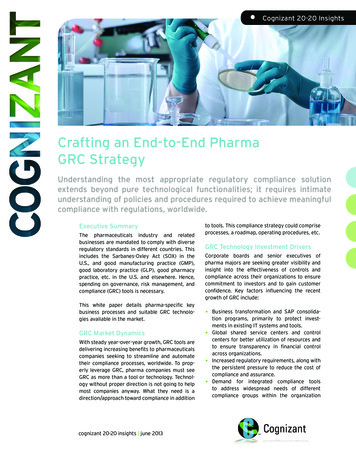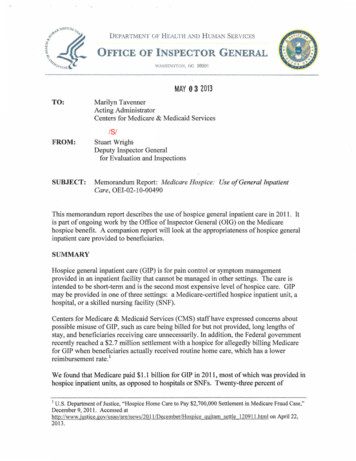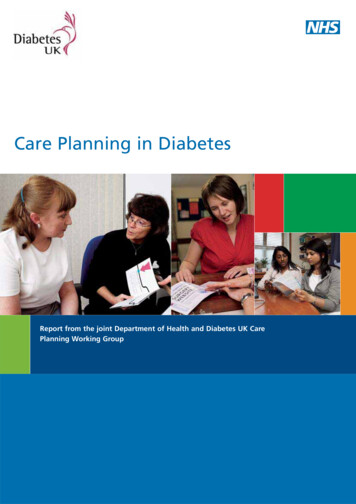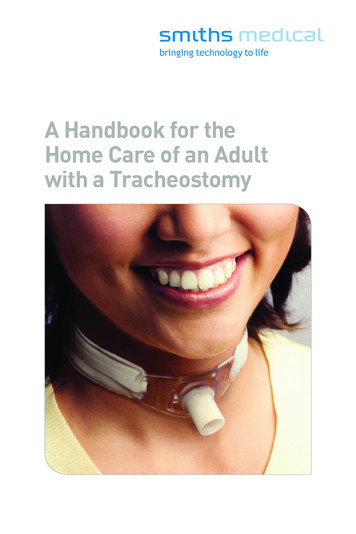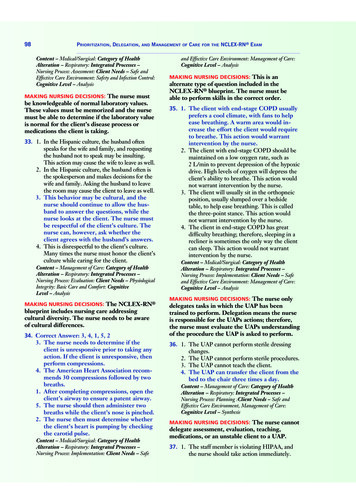
Transcription
3313 Ch04 077–108 14/03/14 4:35 PM Page 9898PRIORITIZATION, DELEGATION,ANDMANAGEMENTContent – Medical/Surgical: Category of HealthAlteration – Respiratory: Integrated Processes –Nursing Process: Assessment: Client Needs – Safe andEffective Care Environment: Safety and Infection Control:Cognitive Level – AnalysisMAKING NURSING DECISIONS: The nurse mustbe knowledgeable of normal laboratory values.These values must be memorized and the nursemust be able to determine if the laboratory valueis normal for the client’s disease process ormedications the client is taking.33. 1. In the Hispanic culture, the husband oftenspeaks for the wife and family, and requestingthe husband not to speak may be insulting.This action may cause the wife to leave as well.2. In the Hispanic culture, the husband often isthe spokesperson and makes decisions for thewife and family. Asking the husband to leavethe room may cause the client to leave as well.3. This behavior may be cultural, and thenurse should continue to allow the husband to answer the questions, while thenurse looks at the client. The nurse mustbe respectful of the client’s culture. Thenurse can, however, ask whether theclient agrees with the husband’s answers.4. This is disrespectful to the client’s culture.Many times the nurse must honor the client’sculture while caring for the client.Content – Management of Care: Category of HealthAlteration – Respiratory: Integrated Processes –Nursing Process: Evaluation: Client Needs – PhysiologicalIntegrity: Basic Care and Comfort: CognitiveLevel – AnalysisMAKING NURSING DECISIONS: The NCLEX-RN blueprint includes nursing care addressingcultural diversity. The nurse needs to be awareof cultural differences.34. Correct Answer: 3, 4, 1, 5, 23. The nurse needs to determine if theclient is unresponsive prior to taking anyaction. If the client is unresponsive, thenperform compressions.4. The American Heart Association recommends 30 compressions followed by twobreaths.1. After completing compressions, open theclient’s airway to ensure a patent airway.5. The nurse should then administer twobreaths while the client’s nose is pinched.2. The nurse then must determine whetherthe client’s heart is pumping by checkingthe carotid pulse.Content – Medical/Surgical: Category of HealthAlteration – Respiratory: Integrated Processes –Nursing Process: Implementation: Client Needs – SafeOFCAREFOR THENCLEX-RN EXAMand Effective Care Environment: Management of Care:Cognitive Level – AnalysisMAKING NURSING DECISIONS: This is analternate type of question included in theNCLEX-RN blueprint. The nurse must beable to perform skills in the correct order.35. 1. The client with end-stage COPD usuallyprefers a cool climate, with fans to helpease breathing. A warm area would increase the effort the client would requireto breathe. This action would warrantintervention by the nurse.2. The client with end-stage COPD should bemaintained on a low oxygen rate, such as2 L/min to prevent depression of the hypoxicdrive. High levels of oxygen will depress theclient’s ability to breathe. This action wouldnot warrant intervention by the nurse.3. The client will usually sit in the orthopneicposition, usually slumped over a bedsidetable, to help ease breathing. This is calledthe three-point stance. This action wouldnot warrant intervention by the nurse.4. The client in end-stage COPD has greatdifficulty breathing; therefore, sleeping in arecliner is sometimes the only way the clientcan sleep. This action would not warrantintervention by the nurse.Content – Medical/Surgical: Category of HealthAlteration – Respiratory: Integrated Processes –Nursing Process: Implementation: Client Needs – Safeand Effective Care Environment: Management of Care:Cognitive Level – AnalysisMAKING NURSING DECISIONS: The nurse onlydelegates tasks in which the UAP has beentrained to perform. Delegation means the nurseis responsible for the UAPs actions; therefore,the nurse must evaluate the UAPs understandingof the procedure the UAP is asked to perform.36. 1. The UAP cannot perform sterile dressingchanges.2. The UAP cannot perform sterile procedures.3. The UAP cannot teach the client.4. The UAP can transfer the client from thebed to the chair three times a day.Content – Management of Care: Category of HealthAlteration – Respiratory: Integrated Processes –Nursing Process: Planning :Client Needs – Safe andEffective Care Environment, Management of Care:Cognitive Level – SynthesisMAKING NURSING DECISIONS: The nurse cannotdelegate assessment, evaluation, teaching,medications, or an unstable client to a UAP.37. 1. The staff member is violating HIPAA, andthe nurse should take action immediately.
3313 Ch04 077–108 14/03/14 4:35 PM Page 99CHAPTER 4 RESPIRATORY MANAGEMENTContent – Management of Care: Category of HealthAlteration – Respiratory: Integrated Processes –Nursing Process: Implementation: Client Needs – Safeand Effective Care Environment: Management of Care:Cognitive Level – ApplicationMAKING NURSING DECISIONS: There will bemanagement questions on the NCLEX-RN . Inmany instances, there is no test-taking strategy;the nurse must be knowledgeable of management issues. The Health Insurance Portabilityand Accountability Act (HIPAA) passed into lawin 1996 to standardize exchange of informationbetween healthcare providers and to ensurepatient record confidentiality.38. 1. This statement warrants intervention because fluids will help prevent dehydrationand renal calculi. The nurse should explain the client needs to increase fluids.2. ROM exercises help prevent deep veinthrombosis (DVT). This statement does notrequire intervention by the nurse. The UAPcan perform skills if taught and performanceis evaluated by the nurse.3. Keeping the client off the buttocks is anappropriate intervention for a client on strictbed rest. This comment does not requireintervention by the nurse.4. Pulling the client across the sheets will causeskin breakdown. Because the UAP is not doingthis, no intervention by the nurse is needed.Content – Medical/Surgical: Category of HealthAlteration – Respiratory: Integrated Processes –Nursing Process: Planning: Client Needs – Safe andEffective Care Environment: Management of Care:Cognitive Level – AnalysisMAKING NURSING DECISIONS: Delegation meansthe nurse is responsible for the UAP’s actionsand performance. The nurse must correct theUAP’s performance to ensure the client is caredfor safely in the hospital or the home.39. 1. The client’s oxygen should always be placedcorrectly but it is not the priority intervention for difficulty breathing.2. Because the client has difficulty breathingwhile lying in bed, allowing the client tosit in a recliner will help the client; therefore, this is the priority intervention.3. Often clients report a fan blowing on theface helps with difficulty breathing but this isnot a priority intervention.4. Slow, deep breaths will not help the clientwith difficulty breathing as much as willsitting in a recliner.Content – Medical/Surgical: Category of HealthAlteration – Respiratory: Integrated Processes – NursingProcess: Planning: Client Needs – Physiological Integrity:Basic Care and Comfort: Cognitive Level – SynthesisMAKING NURSING DECISIONS: In questions thatask the test taker to identify a priority intervention all the options are something a nurse canimplement. The test taker must identify themost important intervention.40. 1. The body naturally begins to slow down, andclients may not wish to take in liquids ornourishment. This can produce a naturaleuphoria and make the dying process easieron the client. IV fluids would interfere withthis process and would increase secretionsthe client cannot handle, thus making theclient more uncomfortable.2. A PEG feeding tube would increase theintake of the client and would increasesecretions the client cannot handle. Thiscan require suctioning the client and furtheraugmenting the client’s discomfort.3. Refusal to take in food and liquids produces a natural euphoria and makes thedying process easier on the client. This isan appropriate teaching statement.4. This is a therapeutic response, but factualinformation is needed by the wife to acceptthe process.Content – Medical/Surgical: Category of HealthAlteration – Respiratory: Integrated Processes –Nursing Process: Implementation: Client Needs –Psychosocial Integrity: Cognitive Level – ApplicationMAKING NURSING DECISIONS: The NCLEX-RN addresses questions concerned with end of lifecare. This is included in the PsychosocialIntegrity section of the test blueprint.41. 1. The home health nurse may be a possibilityif a hospice organization is not available, buthospice is the best referral.2. The nurse would not refer the client to his orher own pastor. The nurse could place a callto notify the pastor at the client’s request,but this would not be considered a referral.3. One of the guidelines for admission to ahospice agency is a terminal process witha life expectancy of 6 months or less.ANSWERS2. The nurse should first ask the staff member not to discuss the client with a friend.Discussing any information about a clientis a violation of HIPAA.3. The nurse should address the staff memberin the restaurant. The nurse could tell theclinical manager, but the nurse must stop theconversation in the restaurant immediately.4. The nurse should not tell the client aboutthe breach of confidentiality.99
3313 Ch04 077–108 14/03/14 4:35 PM Page 100100PRIORITIZATION, DELEGATION,ANDMANAGEMENTThese organizations work to assist theclient and family to live life to its fullestwhile providing for comfort measures anda peaceful, dignified death.4. The hospital social worker is not anappropriate referral at this time.Content – Medical/Surgical: Category of HealthAlteration – Respiratory: Integrated Processes –Nursing Process: Planning: Client Needs – PhysiologicalIntegrity: Physiological Adaptation: CognitiveLevel – SynthesisMAKING NURSING DECISIONS: The nurse mustbe knowledgeable about appropriate referralsand implement the referral to the mostappropriate person/agency.42. 1. This is advising and crossing professionalboundaries. The nurse should not try toinfluence the client in these types of concerns.2. This is advising and crossing professionalboundaries. The nurse should not try to influence the client in these types of concerns.3. This response allows the client to makehis or her own decision. It validates thatthe nurse heard the concern but does notadvise the client.4. This is advising and crossing professionalboundaries. The nurse should not try to influence the client in these types of concerns.Content – Management of Care: Category of HealthAlteration – Respiratory: Integrated Processes –Nursing Process: Implementation :Client Needs –Psychosocial Integrity: Cognitive Level – ApplicationMAKING NURSING DECISIONS: The nurse mustalways remember that nurses have positions ofauthority in a healthcare environment. Nursesmust maintain professional boundaries at all timesand refuse to cross professional boundaries.43. 1. Women tend to see the big picture and seeksolutions based on what makes people feelcomfortable rather than on logic.2. Men often see the world from a logicalperspective and focus on a specificintervention.3. Men tend to ask fewer questions thanwomen, especially if the man perceives thatasking the question will make him lookfoolish or ignorant.4. Men and women communicate verydifferently. The female manager of a maleemployee should recognize the differencewhen attempting to arrive at a common goal.Content – Medical/Surgical: Category of HealthAlteration – Respiratory: Integrated Processes –Nursing Process: Communication: Client Needs – Safeand Effective Care Environment: Management of Care:Cognitive Level – ApplicationOFCAREFOR THENCLEX-RN EXAMMAKING NURSING DECISIONS: There will bemanagement questions on the NCLEX-RN . Inmany instances, there is no test-taking strategy;the nurse must be knowledgeable of management issues.44. 1. The attitude of the staff member changesfrom one day to the next. The “why” is notimportant for the manager to know. Theimportant thing for the manager to know iswhether the staff member can control theattitude.2. The first step is an informal meeting withthe staff member to discuss the inappropriate attitude and how it affects the staff.The manager should document the conversation informally with the date andtime (the staff member does not need tosee this documentation) for future reference. If the situation is not resolved, aformal counseling must take place.3. This step would follow the informaldiscussion if the attitude did not improve.4. This is a step sometimes used to get theattention of the staff member when formalcounseling has not been effective. This stepoccurs just before termination.Content – Management of Care: Category of HealthAlteration – Respiratory: Integrated Processes –Nursing Process: Implementation: Client Needs – Safeand Effective Care Environment: Management of Care:Cognitive Level – ApplicationMAKING NURSING DECISIONS: There will bemanagement questions on the NCLEX-RN . Inmany instances, there is no test-taking strategy;the nurse must be knowledgeable of management issues.45. 1. E-mails should be easy to read and concise.Individuals may not take the time to readand understand poorly worded, lengthye-mails.2. Some communication is appropriate bye-mail, but when discussing a problem withan individual, it is best to use face-to-facecommunication in which both parties cangive and receive feedback.3. Capital letters in e-mails may be interpretedas shouting or yelling at the receiver.4. E-mail communication should be conciseand easy to read. If the e-mail requires alot of information, then the writer shoulduse bullets to separate information.Content – Medical/Surgical: Category of HealthAlteration – Communication: Integrated Processes –Nursing Process: Implementation: Client Needs – Safeand Effective Care Environment: Management of Care:Cognitive Level – Application
3313 Ch04 077–108 14/03/14 4:35 PM Page 101CHAPTER 4 RESPIRATORY MANAGEMENTMAKING NURSING DECISIONS: There will bemanagement questions on the NCLEX-RN . Inmany instances, there is no test-taking strategy;the nurse must be knowledgeable of management issues.Content – Management of Care: Category of HealthAlteration – Respiratory: Integrated Processes –Nursing Process: Implementation: Client Needs – Safeand Effective Care Environment: Management of Care:Cognitive Level – ApplicationMAKING NURSING DECISIONS: There will bemanagement questions on the NCLEX-RN . Inmany instances, there is no test-taking strategy;the nurse must be knowledgeable of management issues.47. Correct Answer: 1, 4, 3, 2, 51. The nurse should begin the care byassessing the client. Remember thenursing process.4. The nurse should have the client’s chestand dressing exposed and should check tomake sure the chest tube is securelytaped at this time.3. The nurse then follows the chest tube tothe drainage system and assesses thesystem.2. The last part of the chest tube drainagesystem to assess is the suction system.5. The nurse should make sure that emergency supplies are at the bedside last.Content – Medical/Surgical: Category of HealthAlteration – Respiratory :Integrated Processes –Nursing Process: Assessment: Client Needs – Safe andEffective Care Environment: Management of Care:Cognitive Level – AnalysisMAKING NURSING DECISIONS: This is an alternatetype of question included in the NCLEX-RN blueprint. The nurse must be able to performskills in the correct order. Assessment shouldalways be the first intervention if the client is notin distress.48. 1. Bronchiectasis is a condition in which thelungs’ airways are abnormally stretched andwidened. This is caused by mucous blockage,which allows bacteria to grow and leads toinfection. Signs/symptoms include coughing,abnormal breath sounds, and clubbing;therefore, the nurse would not assess thisclient first.2. Byssinosis (brown lung disease) is a lungdisease caused by exposure to dust fromcotton processing, hemp, and flax. Signs/symptoms include chest tightness, cough,and wheezing; therefore, this client wouldnot be assessed first.3. Cystic fibrosis (CF) is an inheriteddisease that causes thick, sticky mucus toform in the lungs, pancreas, and other organs. In the lungs, this mucus blocks theairways, causing lung damage and makingit hard to breathe. A pulse oximeter reading of 90% equates to approximately a60% arterial saturation. The nurse shouldassess this client first.4. Pneumoconiosis, known as black lung disease, is an occupational lung disease causedby inhaling coal dust. The signs/symptomsare shortness of breath and chronic cough;therefore, this client would not be assessedfirst.Content – Medical/Surgical: Category of HealthAlteration – Respiratory: Integrated Processes –Nursing Process: Assessment: Client Needs –Physiological Integrity: Reduction of Risk Potential:Cognitive Level – AnalysisMAKING NURSING DECISIONS: The test taker mustdetermine which sign/symptom is not expected forthe disease process. If the sign/symptom is not expected then the nurse should assess the client first.This type of question is determining if the nurse isknowledgeable of signs/symptoms of a variety ofdisease processes.49. 1. Activity intolerance is not priority over gasexchange. If gas exchange does not occur, theclient will die.2. Coping is a psychosocial problem, andphysiological problems are priority.3. Impaired gas exchange is the priorityproblem for this client. If the client doesnot have adequate gas exchange, theclient will die. Remember Maslow’sHierarchy of Needs.4. Self-care deficit is not priority over gasexchange.Content – Medical/Surgical: Category of HealthAlteration – Respiratory: Integrated Processes –Nursing Process: Assessment: Client Needs –Physiological Integrity: Physiological Adaptation:Cognitive Level – AnalysisMAKING NURSING DECISIONS: The NCLEX-RN integrates the nursing process throughout theANSWERS46. 1. The problem is not a nursing problem.The HCP should be discussing the problem with an individual from the department that “owns” the problem.2. This is not a nursing problem.3. This is not a nursing problem.4. This will only make the HCP angrier. TheHCP should be directed to discuss the problem with the department that can “fix” theproblem.101
3313 Ch04 077–108 14/03/14 4:35 PM Page 102102PRIORITIZATION, DELEGATION,ANDMANAGEMENTClient Needs categories and subcategories.The nursing process is a scientific, clinicalreasoning approach to client care that includesassessment, analysis, planning, implementation,and evaluation. The nurse will be responsible foridentifying nursing diagnosis for clients.50. 1. Consolidation indicates fluid or exudatesin the lung—pneumonia. This would notindicate the client is improving.2. Bilateral breath sounds indicate the leftlung has re-expanded and the treatmentis effective.3. Vigorous bubbling in the suction chamberindicates that there is a leak in the system,but this does not indicate the treatment iseffective.4. Crepitus (subcutaneous emphysema) indicates that oxygen is escaping into the subcutaneous layer of the skin, but this does notindicate the lung has re-expanded, which isthe goal of the treatment.Content – Medical/Surgical: Category of HealthAlteration – Respiratory: Integrated Processes –Nursing Process: Assessment: Client Needs – Safe andEffective Care Environment: Safety and Infection Control:Cognitive Level – AnalysisMAKING NURSING DECISIONS: The nurse shouldrealize a normal finding indicates the medicaltreatment is effective. If the nurse is vacillatingbetween two options and one option is equipment the nurse should select the client’s bodyas the correct answer.51. 1. Jugular vein distention would indicate theclient has CHF. This is not a complicationof a loop diuretic.2. Rales and rhonchi are symptoms of pulmonary edema, not a complication of a loopdiuretic.3. Leg cramps may indicate a low serumpotassium level, which can occur as aresult of the administration of a diuretic.4. This would indicate the medication is effectiveand is not a complication of the medication.Content – Medical/Surgical :Category of HealthAlteration – Respiratory: Integrated Processes –Nursing Process: Assessment: Client Needs –Physiological Integrity: Pharmacological andParenteral Therapies: Cognitive Level – AnalysisMAKING NURSING DECISIONS: The nurse mustbe aware of expected actions of medications. Thenurse must be aware of assessment data indicating the medication is effective or the medicationis causing a side effect or an adverse effect.52. 1. Nonmalfeasance means to do no harm.This statement is letting the client knowOFCAREFOR THENCLEX-RN EXAMthat the concern has been heard but doesnot give the client bad news before surgery. The nurse is aware that someonehaving surgery should be of sound mind,and finding out your child is dead wouldbe horrific.2. This is an example of veracity.3. This is an example of paternalism, telling theclient what he or she should do.4. This is a therapeutic response, not anexample of nonmalfeasance.Content – Medical/Surgical: Category of HealthAlteration – Ethics: Integrated Processes – NursingProcess: Implementation: Client Needs – Safe andEffective Care Environment: Management of Care:Cognitive Level – ApplicationMAKING NURSING DECISIONS: The NCLEX-RN blueprint includes nursing care that addressesethical principles, including autonomy, beneficence, justice, and veracity, to name a few.53. 1. The Joint Commission is an organizationthat monitors healthcare facilities forcompliance with standards of care.Accreditation is voluntary, but mostthird-party payers will not reimburse afacility that is not accredited by someoutside organization.2. Accreditation does not guarantee reimbursement, although most third-party payersrequire some accreditation by an outsideorganization.3. Accreditation does not reduce the hospital’sliability.4. Medicare/Medicaid will not review a facilityroutinely if the Joint Commission hasaccredited the facility, but a representativewill review the facility in cases of reportedproblems.Content – Management of Care: Category of HealthAlteration – Respiratory: Integrated Processes –Nursing Process: Implementation: Client Needs – Safeand Effective Care Environment: Management of Care:Cognitive Level – ApplicationMAKING NURSING DECISIONS: The NCLEX-RN blueprint includes nursing care that is ruled bylegal requirements as well as Joint Commission,Medicare & Medicaid Services, Centers forDisease Control and Prevention, and Occupational Safety and Health Administration rulesand regulations. The nurse must be knowledgeable of these standards.54. 1. The nurse should “offer self ” to the significant other. Ignoring the needs of thesignificant other at this time makes thesignificant other feel that the nurse doesnot care, and if the nurse does not care
3313 Ch04 077–108 14/03/14 4:35 PM Page 103CHAPTER 4 RESPIRATORY MANAGEMENTContent – Medical/Surgical: Category of HealthAlteration – Respiratory: Integrated Processes –Nursing Process: Implementation: Client Needs –Psychosocial Integrity: Cognitive Level – ApplicationMAKING NURSING DECISIONS: The NCLEX-RN addresses questions concerned with end-of-lifecare. This is included in the Psychosocial Integrity section of the test blueprint. If unsureof the correct option, selecting an optionaddressing an individual is a better choice.55. 1. Coumadin is an oral, not intravenous,medication.2. The therapeutic PTT results should be 1.5to 2 times the control, or 51 to 68 seconds.The client’s value of 53 is within the therapeutic range. The nurse should continuethe heparin drip as is.3. The INR is not up to therapeutic rangeyet, so warfarin (Coumadin) should beadministered.4. These lab values do not provide any information about aspirin administration, but thenurse should ask the HCP whether aspirin(an antiplatelet) should be discontinuedbecause the client is receiving twoanticoagulants—heparin and warfarin.Content – Medical/Surgical: Category of HealthAlteration – Respiratory: Integrated Processes –Nursing Process: Implementation: Client Needs –Physiological Integrity: Reduction of Risk Potential:Cognitive Level – ApplicationMAKING NURSING DECISIONS: This is an alternatetype of question included in the NCLEX-RN blueprint. The test taker must be able to read achart, must be knowledgeable of laboratory data,and must be able to make appropriate decisions asto the nurse’s most appropriate action.56. 1. A Rapid Response Team (RRT) is calledwhen the nurse assesses a client whose condition is deteriorating. The purpose of an RRTis to intervene to prevent a code. In thescenario described, the situation has not progressed to an arrest. The nurse should call anRRT, but administering oxygen is the firstintervention.2. The first action is to increase the client’soxygen to 100%.3. The nurse could check the ABG results, butthe client is in distress and the nurse shouldimplement an intervention to relieve thedistress.4. A fast-acting inhaler should be used, but notuntil after the oxygen has been increased andan RRT called.Content – Medical/Surgical: Category of HealthAlteration – Respiratory: Integrated Processes –Nursing Process: Implementation: Client Needs –Physiological Integrity: Reduction of Risk Potential:Cognitive Level – SynthesisMAKING NURSING DECISIONS: The nurse shouldremember: If a client is in distress and the nursecan do something to relieve the distress, thatshould be done first, before assessment. The testtaker should select an option that directly helpsthe client’s condition.57. 1. The client may eventually need to be transferred to a facility that accepts long-termventilator-dependent clients, but the nursewould not anticipate this at this time.2. The client on a ventilator will have bloodgases ordered more often than daily.3. The stem does not indicate that the client isready to be removed from the ventilator.4. A client who has been intubated for10 to 14 days and still requires mechanical ventilation should have a surgicallyplaced tracheostomy to prevent permanent vocal cord damage.Content – Medical/Surgical: Category of HealthAlteration – Respiratory: Integrated Processes –Nursing Process: Analysis: Client Needs – PhysiologicalIntegrity: Reduction of Risk Potential: CognitiveLevel – KnowledgeMAKING NURSING DECISIONS: The nurse mustbe knowledgeable of expected medical treatment for the client. This is a knowledge-basedquestion.58. 1. The child’s skin will normally taste salty, butthis is not the priority intervention to teach.2. The parents should be asked about theclient’s stools during an assessment becausethe effectiveness of the pancreatic enzymes isevaluated by the consistency of the stool.This is not the priority intervention becausethe child must take the enzymes beforemonitoring the consistency of the stool.3. Cystic fibrosis is a genetic condition thatresults in blockage of the pancreaticducts. The child needs pancreaticANSWERSfor “me,” then did the nurse provideadequate care to my loved one? Thisaction is very important to assist in thegrieving process.2. The UAP can gather the deceased client’sbelongings.3. The UAP can perform post-mortem care.4. The representative of the organ donationteam will make this request. Organ banksthink it is best for specially trained individuals to discuss organ donation with the significant others.103
3313 Ch04 077–108 14/03/14 4:35 PM Page 104104PRIORITIZATION, DELEGATION,ANDMANAGEMENTenzymes to be administered with everymeal and snack so the enzymes will beavailable when the food gets to the smallintestine.4. Cystic fibrosis is one of the few diseases thatrequires salt replacement, but salt replacement is not more important than taking thepancreatic enzymes.Content – Medical/Surgical: Category of HealthAlteration – Respiratory: Integrated Processes –Nursing Process: Implementation: Client Needs –Physiological Integrity: Physiological Adaptation:Cognitive Level – KnowledgeMAKING NURSING DECISIONS: The nurse must beknowledgeable of expected medical treatment forthe client. This is a knowledge-based question.59. 1. The UAP should be sensitive to the client’spreferences and not insist that the client missthe program.2. The UAP should arrange an acceptable timefor the client, and the UAP can return tocomplete the task at the agreed-on time.3. This is the best instruction for the nurseto give to the UAP.4. The bath has not been refused. The clientdoes not want the program interrupted.Content – Management of Care: Category of HealthAlteration – Respiratory: Integrated Processes –Nursing Process: Implementation: Client Needs –Physiological Integrity: Basic Care and Comfort:Cognitive Level – SynthesisMAKING NURSING DECISIONS: Delegation meansthe nurse is responsible for the UAP’s actionsand performance. The nurse must provideguidance to the UAP.60. 1. Effective group process involves allmembers of the group.2. Unanimous decisions may indicate groupthink, which can be a problem in a groupprocess.3. Effective group process involves all membersof the group, not just two.4. Not allowing deviation from the agenda is anautocratic style and limits the creativity andinvolvement of the group.Content – Management of Care: Category of HealthAlteration – Respiratory: Integrated Processes –Nursing Process: Implementation: Client Needs –Psychosocial Integrity: Cognitive Level – ApplicationMAKING NURSING DECISIONS: There will bemanagement questions on the NCLEX-RN .In many instances, there is no test-takingstrategy; the nurse must be knowledgeable ofmanagement issues.OFCAREFOR THENCLEX-RN EXAM61. 1. The ventilator should be checked todetermine which alarm is sounding. Thisis the first step in assessing the client’sproblem.2. The nurse should assess the ventilator andthe client and then notify the respiratorytherapist, if needed.3. The client should be assessed, but the ventilator may require only a simple adjustment tofix the problem and turn
and Effective Care Environment: Management of Care: Cognitive Level – Application MAKING NURSING DECISIONS: There will be management questions on the NCLEX-RN . In many instances, there is no test-taking strategy; the nurse must be knowledgeable of manage-ment issues. 44. 1. The attitude of the staff member changes from one day to the next.File Size: 801KB
